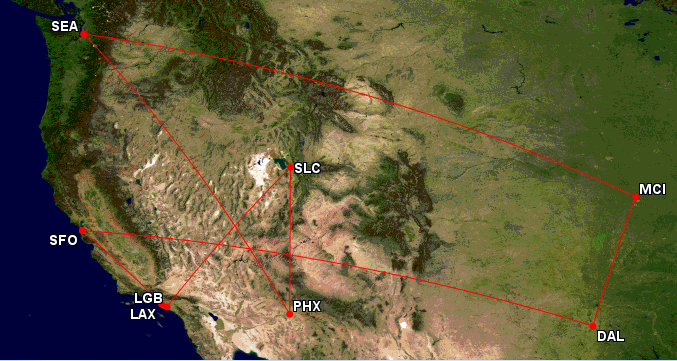“You’re crazy!” That’s the most common reaction I get from non-AvGeeks after describing in detail one of my typical “plane crazy” trips. Unlike a normal person, my travel tends to focus not on the destination, but the journey. That is, the airlines, airplanes, airports, and last but most certainly not least: hap-hazard routing in an effort to add the most diversity to my route map. I just completed one such trip, which I affectionately referred to as my #AirlineSampler.
Planning for this 6k (5,966) mile trek began when I learned United would briefly return a 787 to domestic service. What began as a trip to fly on my first 787 quickly escalated into a cobweb of lines I’d lay across the Great American West (for Missourians, everything west of the arch is west). The trip ended in just under four days, having flown with five airlines and visiting eight airports along the way. Better yet, these would be my very first trips with three of the airlines.
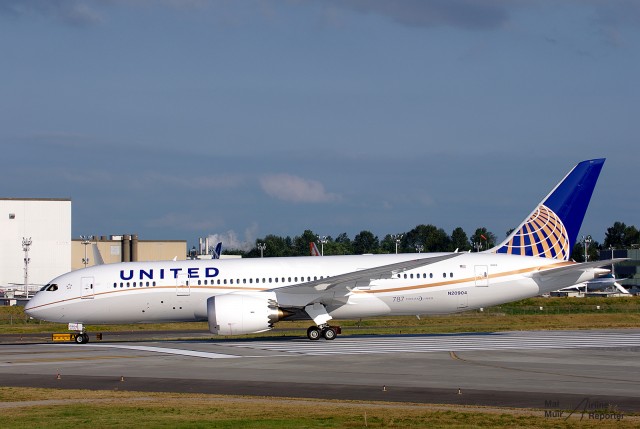
A United Airlines’ Boeing 787-8 – Photo: Mal Muir | AirlineReporter
The experiences I had over this long weekend were both incredible and eye-opening. I want to have enough “runway” as it were to discuss my thoughts on each of the airlines, so we’ll spread these out across a number of posts. At this point, it’s important to note these reviews will be from the perspective of a frequent flier who purposefully chooses Southwest over the other guys most times. I’ve written extensively about my love for Southwest so, for the most part, I’ll leave them out of this series which was focused solely on getting out and exploring the what airline diversity remains in the US. For continuity, I’ll note where I used Southwest for re-positioning and leave it at that.
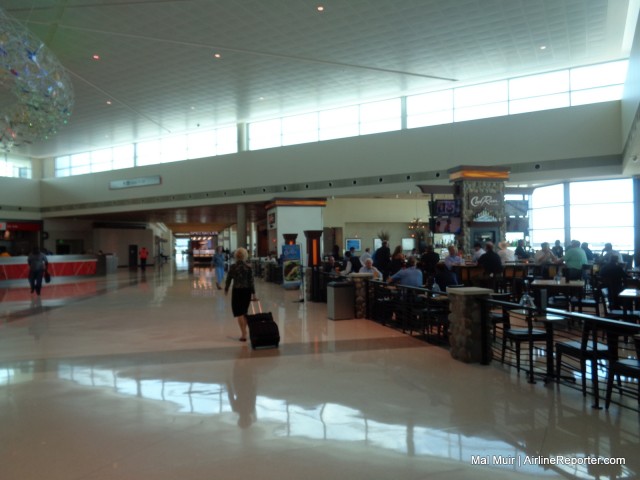
Dallas Love Field’s terminal area with restaurant and bar
In 1974, as Dallas/Fort Worth Airport opened to serve as the main regional airport and airlines moved their flights across town to the new facility, apart from one. Southwest AIrlines decided that their home at Love Field was the best way to service their customers, and from that moment on, the history of the airport would be tumultuous.
In 1979, the Wright Amendment, named after Fort Worth Congressman Jim Wright, set about restricting the airport to certain limitations. As the years went on, the amendment has had a number of changes, easing some of the restrictions.
The Wright Amendment originally restricted airlines with aircraft of greater than 56 seats to only fly services within Texas, or to the four neighboring states of New Mexico, Louisiana, Arkansas, and Oklahoma. Southwest expanded their services out to those states, but the amendment was a severe restriction on their ability to really become the airline that they wanted.
As the years went on, further changes were made, adding Alabama, Kansas, Mississippi, and eventually Missouri to the state list. The biggest changes came in 2006 though, when the repeal of the Wright Amendment began. Although the original changes in 2006 would allow through-ticketing (previously, if you wanted to fly say Dallas to Denver, you would need to have two separate tickets, one to get you to an intermediary city like Albuquerque or Kansas City, the other onto Denver). Eventually, in 2014, the 2006 amendment/repeal would allow long-haul flights directly out of Dallas Love Field.
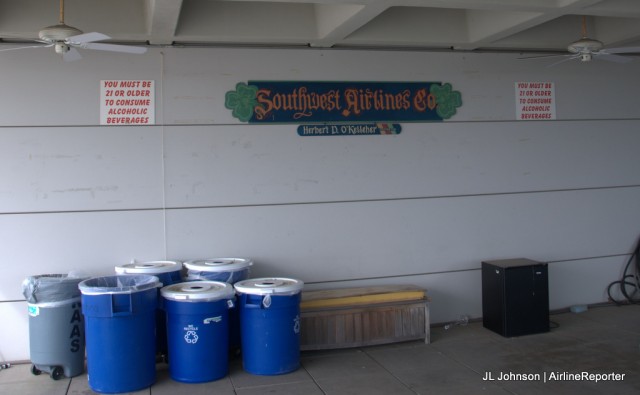
The Southwest Airlines Deck Bar dedicated to its original founder
It is a Monday, your first day on the job with Southwest Airlines. You are nervous and want to make a good impression. You know that whatever you do on your first day, you want to make sure you don’t embarrass yourself, ensuring a second day. That sounds like something that would be going through a new hire’s head right?
ell, the thing is, every Monday all new hires at Southwest Airlines have the best first day introduction to the airline – the Southwest Deck Party.
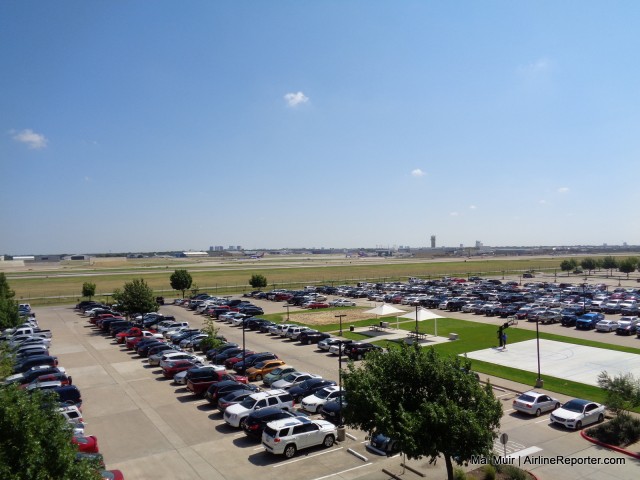
View of Love Field from the Southwest HQ deck
Every Monday, Southwest Airlines has a ’œDeck Party’ at their Dallas Love Field Headquarters. Located on the 3rd Floor, the deck overlooks the runways and the terminal at the airport and is a large open area that is ideal for a bit of a party.
To introduce new hires to the company’s culture, and more than likely to help all company employees relax, Southwest hosts this party with drinks and snacks provided. Not just things to eat or drink either; their are sometimes themed events, but there is always some kind of music.
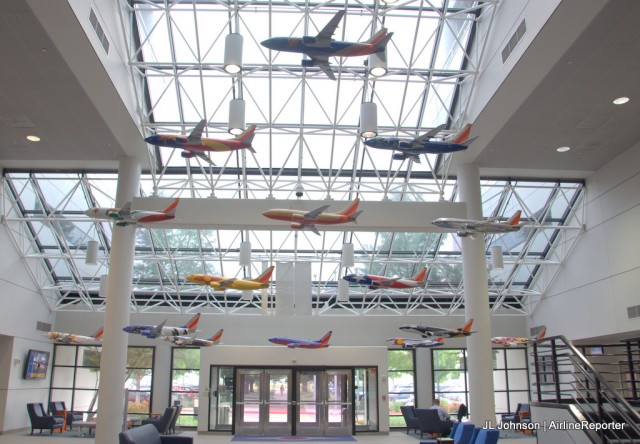
Large models illustrating Southwest’s special liveries hang in the atrium of the company’s HQ
For years I have connected at Dallas Love Field and peered across the aircraft operations area, staring at the home of Southwest Airlines, hoping to one day visit LUV HQ. In the effort of transparency, I’ve made little attempt to conceal my preference for the airline, and we’ll discuss why I think that they’re the best in a bit. But here’s a hint: It’s the culture.
I have a hand-full of friends who work for Southwest and follow a bunch of their employees on Instagram who occasionally post photos from the inside. My desire for a visit intensified when I became aware that the company had recently opened a large addition to their Dallas footprint, just across the street from their long-standing centralized DAL-based HQ. The building, affectionately known as TOPS (for Training and Operations Support), drastically expands the company’s capabilities and makes room for employees of the largest domestic airline to spread their wings.
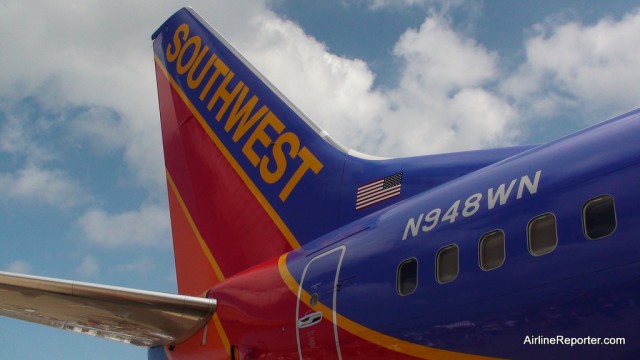
Southwest Airlines tail – Photo: David Parker Brown
After 12 years in corporate America, I have become a self-described boring, stodgy, business-type guy. I think that’s one of the reasons I am so attracted to Southwest’s culture. Because, it’s tough to not have a fun time around people who clearly enjoy their careers and are vested in the mission of their company.
On a recent late-night flight, an attendant came over the intercom to tell us they were turning down the lights and that we were welcome to turn on our overhead lighting. “If you want, push the button with a picture of a light bulb on it.” She continued, “However, pushing the button with the picture of a flight attendant on it will not turn on the flight attendant.”
It was late, we were all tired, and I think it’s fair to say the cabin had let their guard down. This unexpected bit of humor solicited a chuckle from me and a large portion of my 737-trekking peers. It’s these small, unexpected, fun experiences after a long draining day of meetings, charts, and presentations that I have come to rely upon as a part of my decompression ritual.
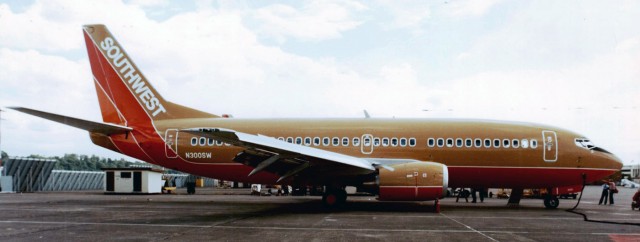
On November 30, 1984, Southwest took delivery of its first Boeing 737’“300, N300SW. It is now preserved at the Museum of Flight at Dallas Love Field. Photo: Boeing
Earlier this year, Southwest Airlines announced a significant number of new direct flights originating from their home base of Dallas Love Field. The newly-announced flights will provide non-stop service to places such as New York, Los Angeles, Denver, and Atlanta.
But why is Southwest, which has been in business since 1971, just now adding these seemingly universal routes to its network? To answer that question, we’ll have to go back in time and brush up on our Dallas-area airport history.
Prior to the opening of Dallas/Fort Worth International Airport (DFW) in 1974, the two cities had a history of contentious competition and missed opportunities. The first was a proposed joint airport way back in 1927. Fort Worth declined the proposal, opting to purchase and operate its own airport independent of Dallas. This led Dallas to build its own airport as well. The end result was the opening of both Love Field (in Dallas) and Meacham Field (in Fort Worth) to commercial air traffic.
In 1940, there was another attempt to cooperate in the construction of a regional airport for both cities, but it was eventually abandoned after neither city could agree on the location or details of the airport. This was followed by the creation of Amon Carter Field, later renamed to Greater Southwest International Airport (GSW), which was barely a stone’s throw away from Love Field.
Finally, in the early sixties, the FAA made it clear to the two cities that it wouldn’t invest any additional money into separate Dallas and Fort Worth airports (quick geography note ’“ downtown Dallas is roughly 30 miles from downtown Fort Worth). This, along with a directive from the Civil Aeronautics Board (CAB), finally pushed Dallas and Fort Worth together in an effort to develop a single large airport to serve the entire metroplex.
Thus, DFW was born.
